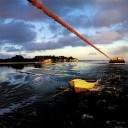
Whangarei Heads
Since 1964 the Marsden Point oil refinery has dominated the southern headland of Whangarei Harbour, giving an industrial stamp to the area. Now, new residential and industrial developments compete for space in the vicinity of the refinery, while across the water the residents of Whangarei Heads watch as their own property values go through the roof. The two harbour heads—each with its distinct character—have become some of the hottest real estate in the north.
Its one of my favourite vistas. At the crest of the Brynderwyn hills, suddenly a panorama of sea and sky, with craggy Bream Head lying like a sleeping dragon on the horizon. A view to anticipate and relish on the road north. How will the patchwork of sunlight and cloud be draped over the sea today? Will the Hen and Chickens be shrouded in haze? Will the white horses be galloping?
Highway One drops down from here, curving towards Bream Bay at Waipu before veering away to skirt Whangarei Harbour. I had travelled this way often, but had rarely branched off to explore the two promontories that form the heads of the harbour—Marsden Point to the south and Whangarei Heads to the north. The longest time I’d spent in the area was a week in the 1970s at Whangarei Heads, on the annual University of Auckland marine biology field trip—a few dozen students scrambling around rocky shores under the tutelage of Professor John Morton.
Then, as now, a defining feature of the two harbour headlands—separated from each other by less than a kilometre of sea was the juxtaposition of heavy industry on one side and coastal village on the other. To the south, the 24-hour flare of the oil refinery; to the north, baches nestled between mountains and sea.
In recent years, change has come to both sides of the harbour. Change, not least, in property prices, which have gone stratospheric. I was curious to find out how these two communities, which face each other across the water, were evolving. Thirty years ago, as a biology student, I was trying to make sense of the zonation patterns of barnacles and seaweeds. Now I was interested in the human inhabitants of these coasts.
[Chapter-Break]
At Marsden Point the biggest in‑dustrial footprint is made on the choicest tract of land—the very tip of the point—by the New Zealand Refining Company. The refinery has been part of the Whangarei landscape for 40 years. Opened in 1964, it was dramatically expanded in the early 1980s and is undergoing a further $180-million upgrade to enable it to meet new fuel specifications which come into force in January 2006.
“It’s part of Kyoto,” Tom Loppnow, manager of the Future Fuels Project, as the upgrade is known, told me as he drove me around the refinery site. “The government requires the sulphur content of diesel to be lowered from 500 parts per million to 50, and the benzene in petrol to drop from three per cent to one. Getting the sulphur down will reduce sulphur dioxide, while benzene is a carcinogen. These changes will bring our fuels into line with the majority of the world’s fuels.”
A native of Wisconsin, Tom has worked on oil projects for 35 years. He was chief fuel engineer during the construction of the methanol-to-gasoline plant in New Plymouth in the 1980s. When the chance came to return to the country, he said, there was no hesitation.

“This is such a pristine location. Environmentally, Marsden Point is head and shoulders above other refineries I’ve been involved with. I’ll give you an example. Some refineries tend not to fix steam leaks. You see clouds of steam everywhere. You don’t see that here.”
We passed “lay-down areas” where stacks of pipes, drums of cable and various components awaited assembly. Many of the process units for the upgrade were pre-fabricated in Thailand before being disassembled and shipped here. Some 300 workers are involved in the project, scheduled for completion in October 2005.
Marsden Point produces more than four million tonnes of product a year—petrol, diesel, jet fuel, kerosene, fuel oil and bitumen, not to mention sulphur for agricultural fertilisers and carbon dioxide for carbonated drinks and as a growth promoter in greenhouses. Almost half of the refinery’s fuel output is carried by pipeline to Auckland, the balance being shipped around the country by road and coastal tanker.
One morning I joined Simon Noakes, skipper of the tug Takahiwai, as he escorted the fuel carrier Taiko from the refinery jetty out through the heads at the start of its delivery run. Takahiwai, built in 2000, is one of a new breed of harbour tugs: short, beamy and ultra-manoeuvrable. Stepping aboard had more in common with entering a glass-walled office than a traditional ship’s bridge. There wasn’t even a wheel. Simon controlled the tug’s twin Z-drive propulsion units with a pair of joysticks, each not much bigger than a computer mouse. The joysticks control two 360 degree rotatable nozzles, and you point the stick in the direction opposite the one in which you want to travel.
Below decks “Steini” the engineer, looked after the two 2500 hp Caterpillar V-16 engines that powered the tug which is part of the North Tugz fleet.Simon manoeuvred the tug so it pressed against Taiko’ s black hull, enabling the ship’s hawsers to be cast off easily, and Steini fed out the main tow line—$17,000 worth of synthetic rope—to crew on Taiko’ s deck.
A call came over the radio from the harbour pilot aboard Taiko: “Give me an easy lift, Simon”—nautical parlance for a steady pull—and moments later Taiko was eased away from her berth. Soon she was past the fairway buoy, steaming her own course, and we watched the pilot boat, a fast inflatable, pull alongside the ship’s black hull. The pilot climbed down a rope ladder and stepped aboard. In these calm seas it was effortless, but Simon said conditions weren’t always so benign. “When you get wind against tide the waves really stand up out here.” He’s seen waves wash right over the pilot boat’s cockpit.

The harbour entrance has long been troublesome to shipping. Barges bringing sand from Waipu or shingle from the Hen and Chickens to Whangarei for concrete-making in the early 1900s sometimes had their entire cargo washed overboard as they approached Marsden Point.
In recent times, high swells and big wave troughs resulted in two oil tankers touching bottom as they entered the harbour. No oil was spilled, but such incidents fuel public anxiety. A half-million-dollar Waverider buoy has been deployed in the stream to give precise readings of swell height, so that shipping can operate safely without exceeding the minimum under keel clearance specified by port authorities.
On the way back to port, Simon showed what his sophisticated tug was capable of. He pulled a few doughnuts, making Takahiwai spin in her own length. He powered the tug sideways, first one way then the other, a strange sensation. Though he didn’t demonstrate it, he said she went from full speed ahead to full astern in just seven seconds.
Simon and Steini pointed out some of the local fishing spots. The sandbanks were thick with pipi and tuatua, they said, and divers spearfished for kingfish around the marker buoys. “Kahawai, trevally, snapper—the fish life around here is amazing for an industrial port,” Simon added. The kingfish are so plentiful that the crews of berthed ships catch them with handlines at night, using nothing but a piece of rag tied on to a hook. Plenty of mullet, too—though perhaps not as many as in the early 1900s, when a dinghy left at anchor overnight would often have a dozen mullet in it by morning.Takahiwai was waiting to bring a log ship in, so I stepped ashore at the jetty of Marsden Point’s new deepwater port.
[Chapter-Break]
Ken Crean, Northport’s chief executive, has a view of two mountains from his Marsden Point office. One is Manaia, on the opposite side of the harbour, its row of volcanic dykes jutting like drunken chimney pots along the summit ridge—the signature skyline of the area. The other is a mountain of woodchips that rises like a golden dune on reclaimed land a couple of dozen metres from his window.
Ken has been in charge of Northport’s operations since the port, a joint venture between Northland Port Corporation and the Port of Tauranga, opened for business in 2002. The economic imperative for building the port, Ken told me, was Northland’s looming “wall of wood”—the impending harvest of millions of cubic metres of radiata pine planted in the 1970s, when the Labour government was offering tax incentives for forest planting on marginal land.
At the same time that foresters were greening the hillsides and dunelands of Northland with pine seedlings, Ministry of Works and regional council staff were pondering where to locate a deep water port to handle the avalanche of log exports those plantings would unleash in 30 years. The shallow water port of Whangarei was not up to the task.
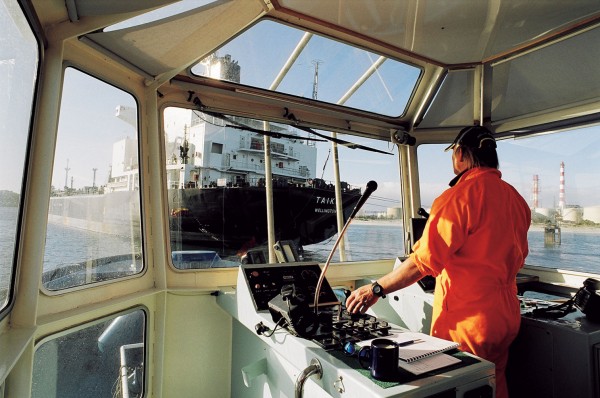
Studies were made of several Northland harbours, including Whangaroa, Mangonui and Opua. Later, Marsden Point was included, and eventually it got the nod. A sheltered location with good depth of water, a significant amount of forest planting south of Whangarei and the fact that the refinery already had a port there all weighed in Marsden Point’s favour.
Surprisingly, the only party to act on the decision was Northland Harbour Board. Then chairman Ralph Trimmer organised the purchase of 150 hectares of land at Marsden Point as an investment in expectation of future development. Ken Crean calls Trimmer’s move a “masterstroke,” and it’s not difficult to see why. The point has become a honeypot, and the bees of industry are swarming around it.
Ken spread out a map and talked about current activity and what was in the pipeline. Forestry will dominate port activity for at least a decade, he said. “Between now and 2014 log volumes are predicted to double, and then to plateau at around four million tonnes a year. Most of the extra two million tonnes a year coming on stream will hopefully be converted into processed product, and we expect a lot of different sawmills, chipboard plants, veneer plants and so on to be built in the region.”

Carter Holt Harvey, which underwrote the development of Northport by guaranteeing a million tonnes of throughput per year for five years, is already operating a laminated veneer lumber mill a kilometre from the port, and has purchased 55 ha of port land, a possible site for a super-sawmill. Other timber processors are looking to establish a presence in the area.
But forestry isn’t the only game in town. Mighty River Power, the electricity supplier that operates the Waikato River’s hydro stations, is considering the feasibility of converting the oil-fired Marsden B power station—built in 1978 but never commissioned—into a coal-fired generation unit. “If that project goes ahead it will equate to more than half a million tonnes of coal coming through the port each year,” said Ken. Various natural gas distributors are looking at Northport as the logical entry point for importing gas into the country post-Maui, he added.
Who knows—there could even be a container terminal in Marsden Point’s future, should Ports of Auckland decide its prime waterfront land would yield a better return with apartment blocks on it instead of shipping containers?

In time, Marsden Point will absorb all the operations of the port of Whangarei. The problem with Whangarei, said Ken, is situation from the rivers and creeks that flow into the harbour. “The port requires continuous dredging to keep it operational. In the past, the silt was pumped ashore into dredge ponds at the edge of the harbour, and this became new port land. But in the mid-1990s the Minister of Conservation made it clear that the habit of covering mangroves in upper-harbour areas was to stop, and that there would be no further dredge ponds allowed once the existing ones were filled.
“Dredging has allowed us to lengthen the life of the port, enabling us to continue taking shallow-draught ships up there while we build the next two berths here at Northport. Those berths should be operational in 2007. We then expect to close down the port at Whangarei.”
For Ken, the only downside of Northport’s location is the fact there isn’t a rail link to Marsden Point. From the community’s point of view, the presence of a growing fleet of logging trucks on the roads is a major social concern—especially since Northland’s roads are overrun by droves of campervans, typically piloted by European tourists used to driving on the other side of the road.
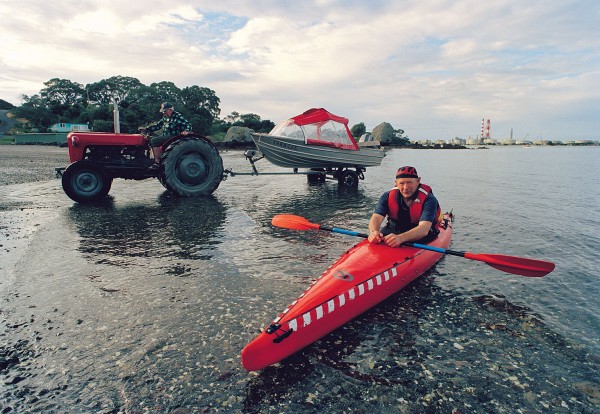
The cost of putting in a branch line from Whangarei and upgrading the trunk line to Auckland was estimated in 2003 to be $86 million. “With that sort of price tag, it’s going to take a minor miracle to get it here,” said Ken. Even so, both regional and district councils are working hard to try to get government funding for a rail link, emphasizing its social desirability, and recently Toll NZ, the company which manages the country’s rail freight, spoke buoyantly of the region’s future as a “prime container transport corridor.”
[Chapter-Break]
Marsden point is proving a magnet for more than industry. The area is in the throes of a residential makeover. Hopper Developments, the company behind the canal housing estates in Pauanui and Whitianga, has planned a 700-lot waterways and marina development for Marsden Bay, most of it to be built on land owned by the port corporation, which is a 50:50 joint-venture partner in the scheme.
A mere tee shot away is the La Pointe residential development—220 lots spread spaciously around a nine-hole golf course and adjacent to that a 50-lot development has commenced. Several luxury homes have gone up at La Pointe, and seven of the nine holes are in play. When I strolled around the site on Labour Weekend—golfers at one end, earthmovers at the other, builders and pavers in the middle—I met San Diego investors David and Jennifer Rodrigue playing a round with their son Marco.
The Rodrigues built their home at La Pointe two years ago, after nine months of globetrotting and looking for somewhere to put down fresh roots. They’d had enough of the hectic pace of California. “I was tired of pantyhose and high heels,” Jennifer confided. “We were ready for a change.”I asked why they chose this side of the harbour “It’s north facing,” Jennifer said, “and we get the pretty view. People on the other side have a view of an oil refinery.”
David was pleased that the developers of the Marsden Point area had “planned for growth.” The proposed construction of a shopping complex, marina and retirement village would be good for the area, he said.
Well, good for some. Those very prospects are helping push up property prices—and rates—to unprecedented heights. “Values have doubled in the last four years,” Bream Bay real estate agent Melva Hartnell told me. No-frills worker houses in the old power station village of Ruakaka were struggling to fetch $100,000 when Melva started selling in the area in 2000. “Now you can’t buy one for under a quarter of a mill,” she said. “The other place that’s gone crazy is the old part of the Ruakaka surf beach. Old baches you wouldn’t have given tuppence for, now you can’t pick up for under 300. And they don’t even have sea views.”“Who’s buying?” I asked.
“A lot of people from Whangarei have woken up to the fact that they’ve got this beautiful area on their doorstep, and are moving out here, but it’s taken pressure from Aucklanders to cause the wake-up.” In some cases, Melva added, the buyers were Aucklanders once removed—people who had relocated or retired to Mangawhai and Waipu and then found those areas had become too crowded or too expensive for them so had shifted further north.
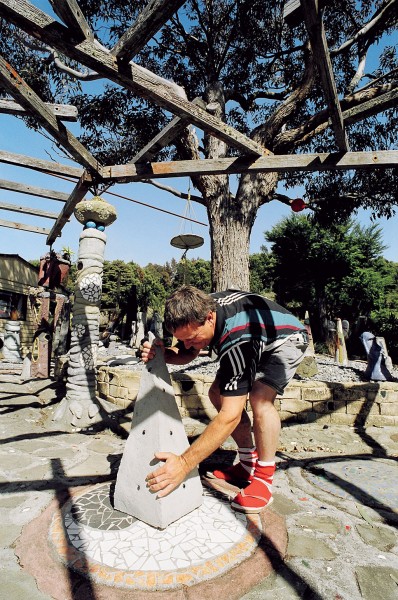
We were talking in the home of Alec Bean, my former grammar school deputy principal, with whom I’d stayed in contact over the years. He and his wife, Margery, were reversing the migratory trend. They had just sold their One Tree Point property and were moving south to Orewa to be closer to family. Some of their fellow retirees were selling up because of the logging trucks that thunder along the Marsden Point road—160 a day. Others felt the area was losing its humble holiday atmosphere. Canals and shopping complexes weren’t their idea of a quiet place at the beach.
Indeed, the old One Tree Point—with its eclectic bach-style architecture, solitary store, venerable tractors for launching the family fizzboat, and farm paddocks just over the fence—is fast disappearing. Street names mirror the changes. Quiet avenues named after seabirds—Curlew, Shearwater, Prion—are passe. The new residential boulevards evoke dreams of travel: Barbados Way, Key West Drive.
I asked Melva if people buying in the area expressed concern about having heavy industry as a neighbour. She said they rarely mentioned it, and were more interested in what facilities were planned and in the quality of the schools. It was nonetheless an unusual mix, she admitted—industrial activity next to a waterways development. “Like putting Pauanui next to Penrose.”
[Chapter-Break]
Gentrification-or at least some degree of social upscaling—has been the trend on the other side of the harbour, too. Once a farming community supplemented by baches and a few retirees, the Heads has become a haven for well-heeled lifestylers and Whangarei commuters. In many cases, people who had a house in town and a bach on the coast have sold the town place, done up the bach and moved out permanently, happy to trade extra driving time for a home by the sea.
In the staffroom of the primary school at Parua Bay, halfway to the Heads from Whangarei, teachers told me that primary-school rolls swelled during the 1970s and 1980s with the first big carve-up of rural land into lifestyle blocks. But rising property values soon put the coast out of reach of first-home buyers with young families, and school rolls started to drop.
Headmaster Tim Hempleman said that, with the roll having fallen to 207, he was having to market the school for the first time. The school was considering offering after-school programmes, which would benefit working parents. “At the moment, if both parents commute to Whangarei it’s more convenient for them to have their children at a school in town, where they can pick them up after school rather than have them come home to an empty house,” Tim said.
The school was having its show day. The classrooms abounded with sand-saucer gardens, vegetable-and-toothpick creations, floating flower arrangements and more. The hall had been transformed into a menagerie. Cats in carry-cages eyed budgies perching on the shoulders or fingers of their young owners. Rabbits, mice and guinea-pigs enriched the musty atmosphere with their own distinctive ambience. Hens clucked in plastic bins which had chicken-wire stretched over the top with holes punched in it so the chooks could poke their heads through.
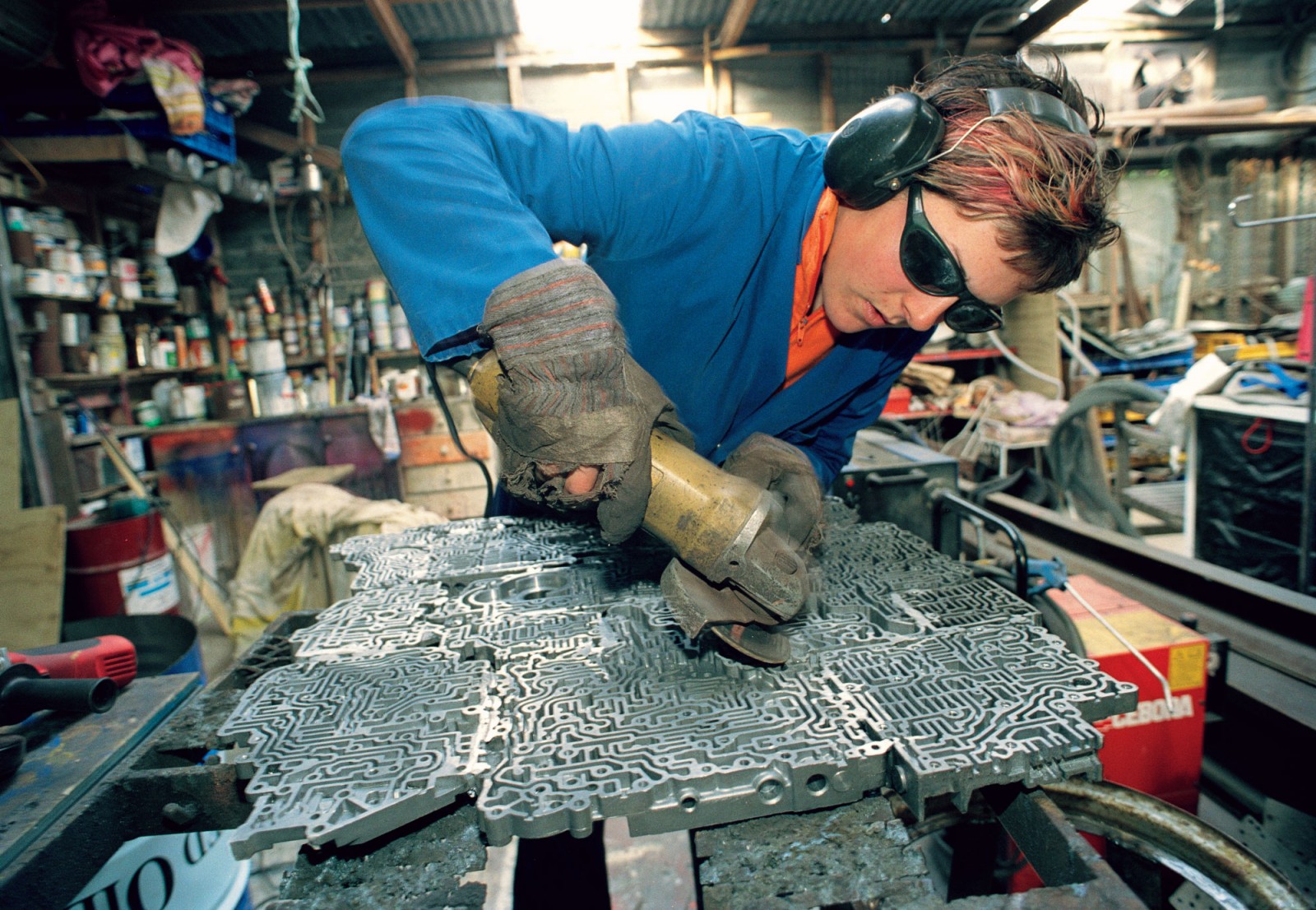
On the sports field, children cajoled protesting calves into walking around a parade course. Only six calves and nine lambs had been entered in the livestock competition this year, Tim Hempleman told me between megaphone announcements—the lowest number he’d seen during 16 years as principal. A sign of the times.
Depending on whom you talk to, Parua Bay is or is not part of Whangarei Heads. Purists would say the Heads starts at McLeod Bay. More inclusive definitions include The Nook, Parua Bay and even Pataua, an estuary south of Ngunguru Bay.
One morning I joined Grant Whiting on the Whangarei Heads school bus run. Normally, Grant’s wife, Pam, drove the bus, but she and daughter Aimie had gone to Auckland for a fashion show. “We take the kids to Auckland just to let them see what they’re not missing,” Grant joked as we set off.
The Whitings live on 20 ha at the end of an unsealed road that stops a kilometre from the sand dunes of Ocean Beach. “We got married up here,” Grant told me. “The invitation said come to the end of the world. We couldn’t have a phone for a couple of years until the phone line moved close enough. Our letterbox is half a kilometre back down the road—that’s as far as the postie wants to come.”
The property originally belonged to Grant’s brother, Paul, who planted it in pines. Paul was lost at sea in 1980 after competing in the Sydney–Hobart yacht race. The yacht he was skippering, Smack-water Jack, disappeared with all hands in the Tasman. “The last thing Paul said to me was, ‘Look after the place till I get back.’ I’m still here after 30 years.”
Grant is a motor mechanic, specialising in tractors. Did the decline in traditional farming mean he had less work? “Just the opposite,” he said with a laugh. “All the small block owners buy a tractor, and often as not it’s an old dunger. Horse trucks are becoming popular, so that’s more work. Kids have cars nowadays—more work!”
He swooped down the Ocean Beach road as he talked. I’d been told that some children stayed on the bus past their drop-off point in the afternoon just to enjoy this rollercoaster ride to the end of the peninsula. Kids were playing on a rope swing under a giant macrocarpa as Grant pulled in to collect them. “It’s a beautiful time of morning to drive round the community. You get to know what’s happening in the various families. You can read children like a book.”Changes in the community? “Well, we’ve become a suburb of Whangarei.
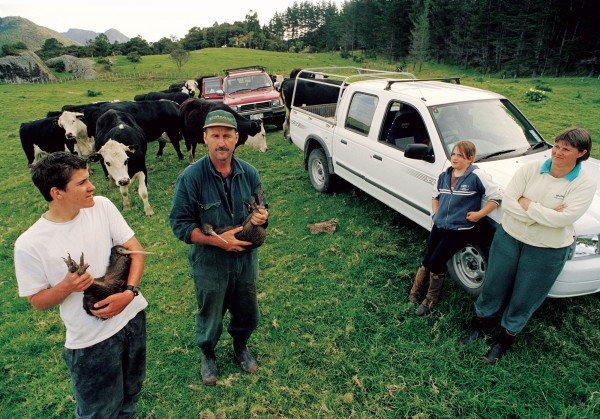
There are more families with dual breadwinners here now. Earning that dollar is becoming so wicked. Used to be that kids waved to every kid they saw, and knew their name. That’s slowly getting eroded away with more people commuting.”
As we passed McKenzie Bay—named after a Nova Scotian sea captain who settled there in 1857—I noticed something strange on the roof of a house that was tucked in to the bank below the road. An animal of some kind, like a cat in mid-stalk, only larger, and with a bushy tail. “Ah, the red fox,” said Grant. Local artist Douglas Chowns, who lives with his wife, Meg, in the original McKenzie homestead, made the creature (based on the character in Robert Louis Stevenson’s Kidnapped) to amuse local schoolchildren. He would move it to a new position on the roof every few days.
Grant drove in to the school, which is positioned dramatically under the shoulders of Manaia. The children filed out, every one thanking him for the ride. On the way back to his place, Grant told me about one of his neighbours, a farmer who had recently been offered $28 million for his property. “Nope. Not selling. Where would he go? You could move to more productive farmland, but where could you find a better lifestyle?”
[Chapter-Break]
Stoat trapper, control advocate, kiwi tracker, farmer liaison, good keen man. That’s Todd Hamilton. Freckled, sociable, down-to-earth, he struck me as a cross between David Bellamy and Barry C rump. He is employed two days a week by the Whangarei Heads Landcare Forum, an administrative collective of nine separate Landcare Trust groups which operate in the area, funded by Transpower, BNZ Kiwi Recovery and government biodiversity money. (The Landcare Trust movement is a community-based initiative fostering sustainable land management and protection of biodiversity.)
I spent a morning crisscrossing the Heads with him as he checked his traps. The first thing that became apparent was that you can’t just plunk down a trap anywhere and expect to achieve results. “Random trapping makes as much sense as random fishing,” Todd said. Successful anglers fish the features—such as reefs and drop-offs—and it’s the same with setting traps. You have to think about the paths the animals are likely to take, their favoured runs. Fence lines, bush edges and stream banks are likely stoat hunting routes, and sheltered spots under rocky overhangs also “fish well,” said Todd.
Once you’ve selected a site, it’s a matter of presenting the bait as enticingly as possible. Todd uses salted rabbit predominantly, occasionally varying the fare with smoked possum. The problem with the possum, he said, is that after a long, tiring day traipsing around the forest, that smoked meat starts to smell mighty good to a human nose.

At each site Todd uses a pair of Fenn traps inside a wooden or plastic tunnel. Fenns—humane successors to gin traps have a pressure plate which, when depressed by a careless paw, causes a pair of powerful jaws to snap shut, breaking the animal’s spine. The bait is placed on a spike between the two traps.Todd prepared each trap site meticulously, sweeping the soil around both ends of the tunnel with a twig and making palisades to guide an animal towards the entrances. “I treat each trap as if it’s the only one I’ll set,” he said. “It’s just like fishing: treat every bite as if it’s the fish of your life.“I’m not blowing my horn, but expertise makes a difference. In our first year we knocked the snot out of the place. Fifty-five stoats, 45 weasels and one ferret, plus 18 feral cats.”
We were walking up a small stream near Taurikura Bay when Todd said, “Look up.” On the bank just above me towered a monster kauri, three metres across at the base of its trunk and ramrod straight. “How did they miss this one?” Todd said. “Or did they think it would be too hard to get it out?”
In the early 1800s these Whangarei Heads hillsides were stripped of their kauri, which were dragged down to Taurikura Bay and pushed into the water, there to be formed into rafts for towing to Auckland.
As early as 1842, local settler Robert Mair lamented the forest’s disappearance. “The Goth has been here with the axe and the firebrand,” he wrote.Today the sentiment along this coast is all about protection and restoration, the litmus test being: Is it safe for kiwi?
Todd opened a trap and removed a dead rat—not the species he was after but a nasty piece of work all the same. “See how he’s caught?” he said. “He triggered the first trap and got nailed by the second. He jumped right across.” Rats are mad, Todd reckons. While stoats approach traps with ultimate caution, rats seem to enter the tunnels at the run. “You catch them by the leg, the tail, the head.”
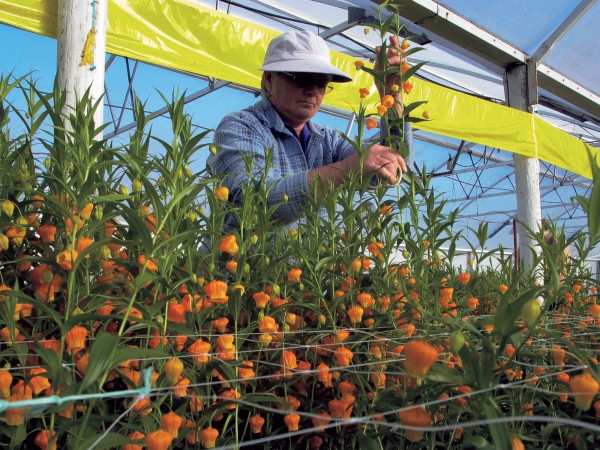
We stopped at the Taurikura store for a burger and a latte—a combination of old and new that seemed to me to typify the Heads—then spent the afternoon engaged in the happier part of Todd’s job: monitoring kiwi. First up was Oscar, a bird that has successfully fathered four chicks on a spit of land called The Nook.
Todd tuned into the frequency of Oscar’s transmitter on his receiver, and, holding a directional aerial in front of him, led the way through regenerating forest. Much of The Nook is scruffy country, full of gorse and woolly nightshade. But it’s riddled with kiwi, Todd said. “Fact is, you’re more likely to find kiwi in gorse than in native bush. You can dig burrows for them in beautiful loamy soil under kauri forest, where there are big fat native worms to eat, and the blighters head straight for areas of Kikuyu and pampas. What people think is low biodiversity is good kiwi country.”
Oscar wasn’t hard to find. He was holed up inside a massive puriri stump, with just his shaggy derriere showing. We clambered over the stump poking a torch into its multiple holes and crevices, and marveling at what a good kiwi nest site this was. Nest site? This was a kiwi motel, where any resident would have the choice of a dozen different rooms.
Todd changed to the frequency of one of Oscar’s offspring and walked around with his receiver, pointing it this way and that, trying to discern in which direction the beeps were loudest. Eventually he held it next to a hollow puriri branch. “The chick’s in there,” he said, pointing at a bulge halfway up the branch and moving the receiver over it the way a person might use a metal detector at the beach to find a lost ring. We peered up through an opening, but the chick was out of torch-beam range.
But not out of stoat range, Todd said. Stoats, the deadliest of the four-legged “Eco-terrorists” arrayed against our national bird, kill an estimated 15,000 North Island kiwi chicks a year—60 per cent of all chicks born. No wonder the kiwi population is in trouble. It is not until a chick reaches a little over a kilogram in weight that it is considered stoat-safe.
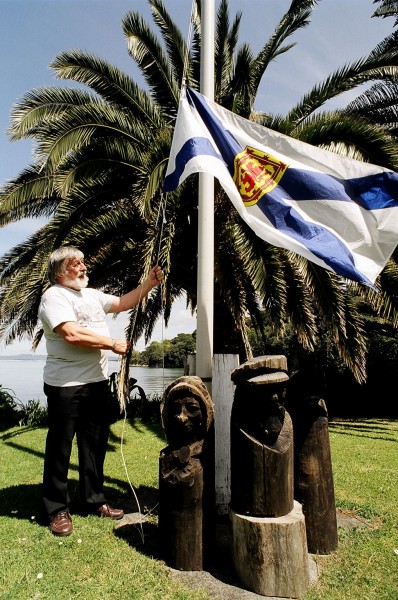
A chick named Annie, another of Oscar’s progeny, had just reached that magic weight, and Todd wanted to change her transmitter, which was nearing the end of its battery life. We climbed down a ridge, listening to the receiver beeping strongly, but seeming to get no closer to the source. The terrain can play all sorts of tricks, Todd said, causing the signal to reflect and sending the tracker in the wrong direction. It can be confusing, too, if earth moving equipment is being used across the harbour at Marsden Point. The beeps of a reversing truck or dozer sound almost identical to those of a kiwi receiver, and if the wind is blowing across the harbour the sound levels can be similar.
“Where are you, Annie dear?” Todd murmured as we traversed the valley floor.Eventually he homed in on a grassy thicket a few metres in diameter. He walked around it, holding the receiver aloft and getting loud beeps that said “Kiwi in residence.” He started carefully separating clumps of grass while I watched the perimeter exits. He worked methodically through the thicket, turning up a dozen or more beautifully concealed roosts—but no Annie.Todd scratched his head and tried again with the receiver. “She’s definitely in there,” he said, and started searching once more. It seemed we had Macavity the Mystery Kiwi on our hands.
Suddenly I saw a grey shape speeding away into the teatree, like a squat, ground-hugging version of Roadrunner. “There she goes,” I yelled, not sure if I should give chase. “Let her go,” said Todd. “The transmitter can wait till next time.”Annie’s is a success story—so far. She no longer has to contend with stoats, but she is still at risk from another species: Canis familiaris, the family pooch. Dogs are murder on kiwi, and a major part of Todd’s work is informing Heads residents that a wandering dog is a potential kiwi killer.
He has no truck with the “Not my dog” response of pet owners who are convinced their adorable mutt wouldn’t hurt a fly. Dogs are hard-wired to be interested in kiwi, Todd says. Something to do with the smell, he thinks. “If I’ve been handling a kiwi, when I go home my dog is all over me like a rash. If I’ve been handling stoats or rabbits, the dog’s not interested.”
As important as chick survival is to the kiwi’s long-term prospects, the loss of adult birds to dogs can set the population back even more severely. Some scientists now think that kiwi are capable of living for 100 years. The loss of breeding potential caused by the death of an adult is considerable.
“We can sustain the occasional farm dog bringing home a kiwi once in a while,” said Todd. “What we can’t sustain is a wandering pet that isn’t tied up at night and kills birds on a regular basis.”
After we’d finished the monitoring round, Todd, wearing his community liaison hat, called in on Murray Jagger, who farms on the eastern side of Manaia. Murray’s family has been farming at the Heads since the 1850s. His great-grandfather was a Nova Scotian sea captain, one of the immigrants who settled here and in Waipu.
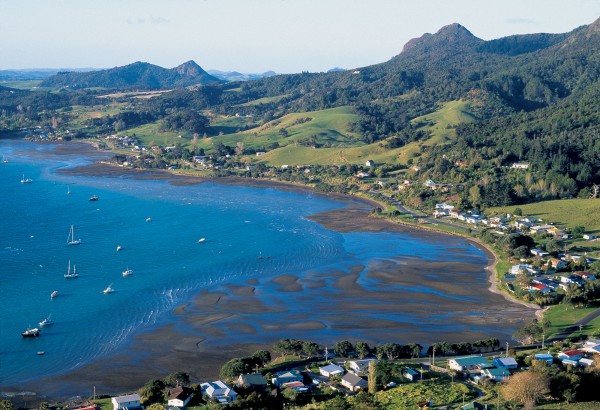
Murray and his father, Eric, give Todd free rein to trap on their property, and Eric looks after several traps himself. “Without the support of farmers like the Jaggers, the kiwi project would be dead and buried,” Todd said. Apart from the practical support farmers give, their properties provide a buffer between residential areas and forest, which is important for keeping kiwi away from dogs.
That buffer is getting thin in places as farmers subdivide their land into ever-smaller (but ever-more expensive) blocks. Murray spelt out the problem: “There used to be 15 dairy farms in the district. Now there’s three. We’re milking 450 cows. Then there’s an organic farm at Ocean Beach milking 150, and a spring calf operation milking 100. There are a few beef farms, but the rest is lifestyle blocks. Out of 145 children at the Whangarei Heads School, our daughter is now the only one from a farming family.
“It’s sad in a way that the Heads has gone from being a farming-based community, plus a whole lot of baches and some retired people, to now the majority being commuters. Thirty years ago the school was the hub of the community. Everyone knew each other and it was vibrant. Today people are more transient and less civic minded. Not so prepared to volunteer and be involved.”
Murray isn’t impressed by the dollar-driven carving-up of land, either. “I get a bit frustrated with the greed element—the decision to chop the land up into bits rather than to take less income but have it stay as a whole. I suppose I look at things slightly differently. There’s a sense of family obligation. How can you walk away from 150 years in a district? I’d like to think we could be here for another 150. Because of that, you want to try to leave things in a better condition than when you started.”
Which is where the Landcare Trust and the kiwi project come in. A few days later, at dusk, I was on Murray’s farm again as two young kiwi were released into forest bordering the property. It was a special moment: Murray’s family, Todd, DoC kiwi specialist Sue Bell, all wishing “Godspeed” to the gangly birds, while a mob of Murray’s heifers watched in the background.“To leave things in a better condition than when you started.”
[Chapter-Break]
Helping the community affirm its identity is at the heart of an arts collaboration by two Urquharts Bay women. Heather Hunt, a designer, and Ellie Smith, a photographer, formed The Heads Proposal because they felt “art and living were becoming too separated.”
Their first project was a snapshot exhibition (subsequently published) called “The Local I.” People were invited to submit a snapshot showing what the Heads meant to them. Ellie said that when the pictures came in they found the same scenes cropping up again and again: kids messing about in dinghies, big snapper, dolphins in the bay, picnics. “In the end it didn’t seem to matter who the individuals were, there was this shared cultural understanding.
“One of the reasons the snapshot project worked so well is that everybody lives here for a reason. It’s not one of those places people just find themselves by accident. Living here involves a conscious choice to move or stay.”
“Another reason is the sense of turan‑gawaewae people have about this area,” Heather said. “There are generations-worth of baches here. People who have grown up holidaying at the Heads keep coming back because of the fond memories they have. The book tapped into those emotional connections to the mountains and the beaches.”
For Annette Hall and her 96-year-old mother, Margery, the bach at Reotahi Bay is a house of many memories. Annette spoke of crossing dewy paddocks every morning to collect a bucket of milk from the local farmer. Once a week they would walk out to the main road at McLeod Bay to pick up a package of meat and bread from town, which the bus driver would fling out of his window without stopping. “You had to be careful what you touched in Eddie McLeod’s store,” Annette said. “He kept baited rat-traps in the sacks of grain in front of the counter.”
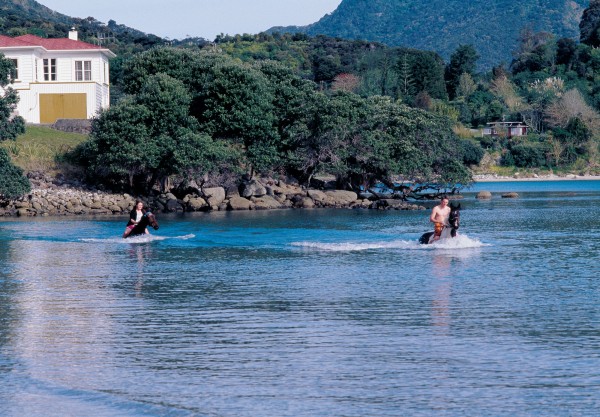
As well as fostering art in the community, Heather and her husband, Martin, own one of the larger businesses at the Heads. They export the bulbs and blooms of Sandersonia aurantiaca, known in the gardening world as Christmas bells or Chinese-lantern lilies (though the species is actually a native of South Africa). The week I was at the Heads they picked 70,000 stems from greenhouses near Murray Jagger’s dairy farm—their biggest crop.
They’re finicky flowers to grow, Heather told me, bending over to snip a bunch of the delicate orange bells. Feeding, watering and disease-control regimens have to be rigorously maintained or an entire crop can be lost. When the Hunts started growing Sandersonias 13 years ago, the horticulturalist who taught them the finer points of cultivating the plants warned them: “If you turn your back for a moment they’ll bite you.”
It’s also labour-intensive. Martin and Heather’s daughters, Marita and Elsa, groaned as they told me about the countless hours they’d spent “untucking”—separating tangled leaves so that the flower stalks would grow perfectly straight. I noticed that many of the pickers sat on stools to save their backs as they worked down the rows of blooms. That night, boxes of Christmas bells would be on their way to Japan—the principal market—as well as to other Asian countries, the US and Canada. In a coalsto-Newcastle twist, South Africa has started importing New Zealand-grown bulbs, as the species is protected in its homeland.
One afternoon, when, mercifully, the equinoctial westerly that howls down the harbour had dropped away to a mere puff, Martin Hunt took me around the coast to Bream Head in his 1920s Collings and Bell-built launch Manaaki. Kauri launches like Manaaki hark back to an era when the only reliable transport to the Heads was by sea. The coast road was a clay track, an impassable quagmire in wet weather and rutted when dry into flint-hard stairs by the hooves of the cattle that were driven to the freezing works at Reotahi Bay. Heads residents used to collect their stores and mail from Marsden Point by rowing across the harbour, and trips to Whangarei were made by launch.
As we motored out of Urquharts Bay, Martin pointed to a World War II gun emplacement on the hill separating Urquharts from Smugglers Bay. The six-inch naval cannon could fire 18 km out to sea through the saddle between Bream Head and the rest of the peninsula, he said. The only time it was discharged the recoil demolished an equipment shed nearby.
We passed inside a rock called The Frenchman and rounded Busby Head, its name recalling one of the important characters in early colonial history. James Busby, famous (or infamous, depending on your point of view) for drafting the Treaty of Waitangi, bought 28,000 hectares of land around Ruakaka in 1839. Payment was in the standard barter currency of the day: trousers, shirts, rifles, spades, hatchets, gunpowder, etc, plus forty pounds in gold. The sale—like many other pre-Treaty land sales—was disallowed by the government after 1840.
Black volcanic cliffs rising up to Mt Lion cast dark reflections on the glassy sea surface close to the coast. The water looked very fishable. Several small boats were anchored, rods out, trying for snapper and terakihi.Peach Cove, midway between Busby Head and Bream Head, was destined for a rather different fishing enterprise—caged farming of kingfish—until local opposition led to the scuppering of the project in 2003. Martin was one of the organisers of the Protect Peach Cove campaign, a two-year fight that eventually prevailed by showing that the aquaculture venture’s resource consents did not adequately cover the likely environmental impacts.
Martin said he first opposed the project on aesthetic grounds. It seemed ludicrous to him that one of Northland’s most distinctive headlands—and a nature reserve to boot—should be sullied by a conglomeration of cages lying just offshore. “It would have looked like a picket fence out here,” he said. But as he and Heather learned more about fish farming—drawing especially on information on salmon ranching in North America—they became concerned about the negative impact of fish-farm detritus on the marine environment. This aspect became the focus, and clinching argument, of the campaign.

Heather felt the community had had a narrow escape from a potentially destructive enterprise. “New Zealand’s coast is under a huge threat, and people don’t realise. It took this campaign to show us how vulnerable we are to ill-considered ‘think big’ schemes.”
Another proposal greeted with alarm by some locals is that of running a car ferry between Marsden Point and Whangarei Heads. Just as the procession of logging trucks has given some Point residents the heebie-jeebies, the thought of an endless stream of campervans from across the harbour is anathema to many Heads folk.
Each side of the harbour has something the other hasn’t, and both communities seem comfortable with their particular slant on coastal living. The go-ahead south has accessibility, employment and the imminent accoutrements of development—marina, shopping complex, recreational facilities. The laid-back north has the quiet life more remote, more traditional, closer to nature. A place where on a weekday morning, as you walk with the kids to the school bus pick-up point, you might watch orca chasing stingrays in the bay. Or in the evening hear a kiwi call while watching a huge oil tanker berth just over the water.












